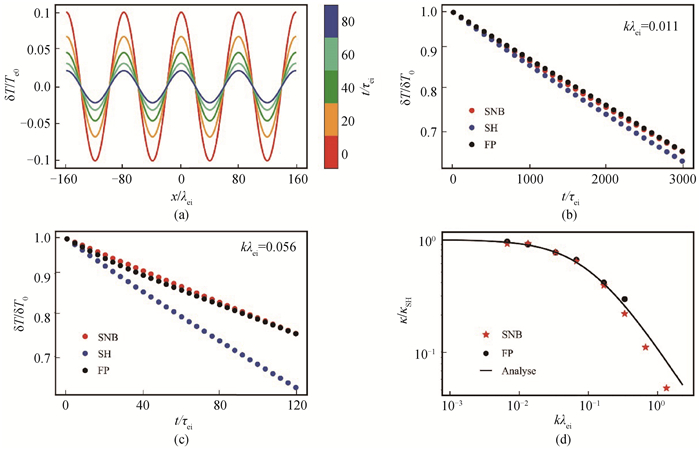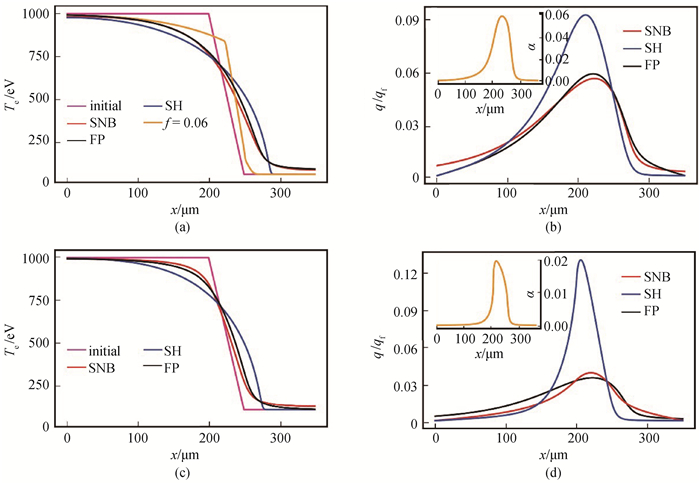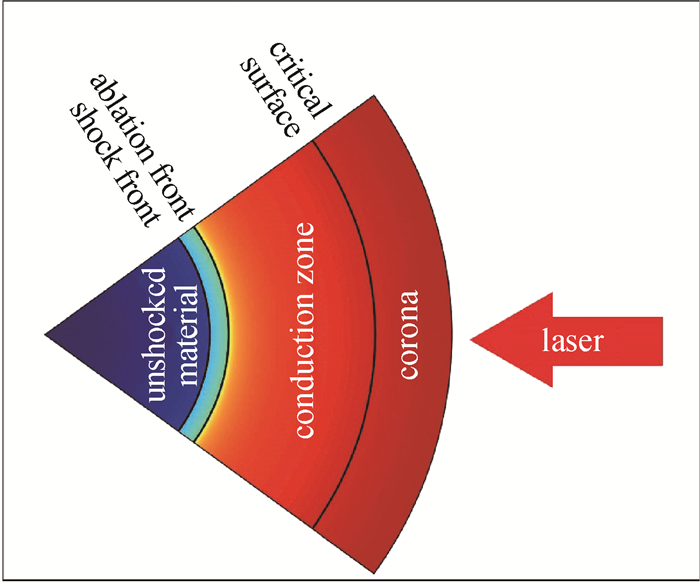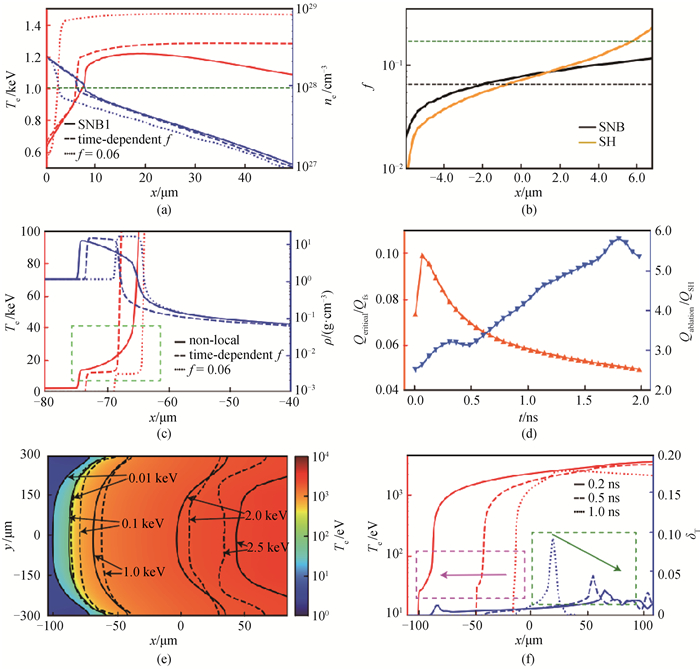计算物理 ›› 2023, Vol. 40 ›› Issue (2): 232-240.DOI: 10.19596/j.cnki.1001-246x.8616
所属专题: 贺贤土院士从事科学研究工作60周年暨激光聚变相关研究进展专刊
• 贺贤土院士从事科学研究工作60周年暨激光聚变相关研究进展专刊 • 上一篇 下一篇
收稿日期:2022-08-15
出版日期:2023-03-25
发布日期:2023-07-05
通讯作者:
乔宾
作者简介:袁文强,男,博士研究生,研究方向为高能量密度物理,E-mail:wqyuan@pku.edu.cn
基金资助:
Wenqiang YUAN( ), Zhonghai ZHAO, Bin QIAO*(
), Zhonghai ZHAO, Bin QIAO*( )
)
Received:2022-08-15
Online:2023-03-25
Published:2023-07-05
Contact:
Bin QIAO
摘要:
将考虑非局域效应的电子热传导模型耦合到辐射流体程序中, 通过两种解析情况下的测试, 计算结果与Fokker-Planck程序计算结果基本一致。将该程序应用到纳秒激光与固体靶相互作用上, 发现电子热传导的非局域效应主要体现在相互作用早期等离子体冕区临界密度面先增大后减小的限流作用和后期烧蚀面附近逐渐增大的预热效应。这对理解惯性约束聚变尤其是直接驱动中的激光能量沉积和传输、流体力学不稳定性的产生与发展具有重要意义。
袁文强, 赵忠海, 乔宾. 辐射流体程序中的非局域电子热传导[J]. 计算物理, 2023, 40(2): 232-240.
Wenqiang YUAN, Zhonghai ZHAO, Bin QIAO. Nonlocal Electron Heat Conduction for Radiation Hydrodynamics Code[J]. Chinese Journal of Computational Physics, 2023, 40(2): 232-240.

图1 Epperlein-Short test结果(a) 温度扰动随时间的变化;(b) kλei=0.011和(c) kλei=0.056时SNB、SH和FP三种计算模型得到的温度扰动随时间的衰减;(d) 非局域的热传导系数和经典系数的偏差κ/κSH与表征非局域参数kλei的关系(黑色实线表示文献[20]中的解析拟合结果, κFP/κSH=1/(1+50kλei)。)
Fig.1 Results of Epperlein-Short test (a) evolution of temperature perturbation, decay of temperature perturbation obtained by SNB, SH and FP models when (b) kλei=0.011, (c) kλei=0.056, respectively; (d) the relationship between the deviation κ/κSH of the non-local heat conduction coefficient and the classical coefficient and the characteristic non-local parameter kλei. (The solid black line represents the analytical fitting result, κFP/κSH=1/(1+50kλei) in Ref.[20].)

图2 Heat-bath problem结果(a)、(b) 低Z材料(Z = 2)在不同计算模型(SNB, SH, FP)下的温度分布和热流分布; ((a)粉色曲线为初始温度分布,其余曲线为80 ps后的温度分布,(b) 子图为此时非局域参数α=λei/Lt的分布。);(c)、(d) 高Z材料(Z = 50)的对应图
Fig.2 Simulation results of heat-bath problem, (a), (b) are spatial distributions of electron temperature and heat flux of low Z material (Z = 2) under different models (SNB, SH, FP), where the pink curve in (a) is the initial temperature distribution with the other curves at 80 ps and subgraph in (b) shows the distribution of the non-local parameter α; (c) and (d) are the corresponding graphs of high Z material (Z = 50)

图3 纳秒激光与固体相互作用示意图(按照主导物理的不同,分为3个界面,4个区域:从外到内分别是冕区,临界密度面,热传导区,烧蚀面,冲击区,激波面,未冲击区域。)
Fig.3 Schematic diagram of ns laser interaction with solids (According to the different dominant physics, it is divided into three interfaces and four regions: coronal region, critical surface, conduction zone, ablation surface, shocked ablator, shock front, and unshocked material.)

图4 激光与塑料靶相互作用模拟结果(a) 0.1 ns时刻,SNB、随时间变化限流因子和f = 0.06三种模型下的等离子体冕区的温度、电子数密度分布,红线表示温度,蓝线表示电子数密度;(b) 0.1 ns时刻热传导区在SNB和SH模型下的限流因子;(c) 1 ns时刻,临界密度面附近的电子温度和流体密度分布;(d) 临界密度面的限流因子和烧蚀面的预热效应随时间的演化;(e) 考虑非局域热传导的二维激光烧蚀温度分布,实线和虚线分别代表SNB模型和f = 0.06模型下的温度等高线;(f) t = 0.2, 0.5, 1.0 ns时刻轴线上的温度和努森数分布
Fig.4 Simulation results of laser-plastic interaction (a) Electron temperature and number density distribution of corona under SNB, time-dependent limiting f and f = 0.06 models at 0.1 ns. (The red line represents temperature and the blue line represents number density.); (b) flux limited factor of conduction zone at 0.1 ns under SNB and SH models; (c) distribution of electron temperature and fluid density near the critical density surface at 1 ns; (d) the evolution of flux limited factor f at critical surface and the preheating effect at ablation surface; (e) map of electron temperature in 2D simulation with SNB model, where the solid lines are temperature contours while dashed lines are corresponding contours in simulations with f = 0.06 model; (f) profiles of electron temperature and Knudsen number at 0.2, 0.5 and 1.0 ns along the central axis of 2D simulations
| 1 |
|
| 2 |
|
| 3 |
DOI |
| 4 |
|
| 5 |
|
| 6 |
DOI |
| 7 |
DOI |
| 8 |
|
| 9 |
DOI |
| 10 |
|
| 11 |
|
| 12 |
|
| 13 |
DOI |
| 14 |
DOI |
| 15 |
DOI |
| 16 |
DOI |
| 17 |
DOI |
| 18 |
DOI |
| 19 |
DOI |
| 20 |
|
| 21 |
DOI |
| 22 |
DOI |
| 23 |
DOI |
| 24 |
DOI |
| 25 |
DOI |
| 26 |
DOI |
| 27 |
DOI |
| 28 |
DOI |
| 29 |
DOI |
| 30 |
DOI |
| No related articles found! |
| 阅读次数 | ||||||
|
全文 |
|
|||||
|
摘要 |
|
|||||
版权所有 © 《计算物理》编辑部
地址:北京市海淀区丰豪东路2号 邮编:100094 E-mail:jswl@iapcm.ac.cn
本系统由北京玛格泰克科技发展有限公司设计开发
